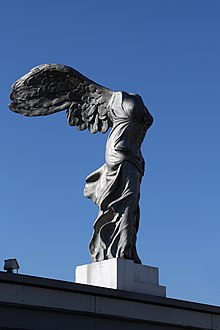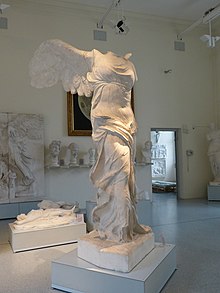Winged Victory of Samothrace
Nike of Samothrace is the name given to a Greek sculpture depicting Nike, the goddess of victory, now in the Louvre in Paris. It was found in the sanctuary of the Kabirs on the Greek island of Samothrace. It was probably created around 190 B.C. It is assumed that Rhodian sculptors created the statue.
The French vice-consul in the Ottoman Empire, Charles Champoiseau, found the fragments of the Nike statue in 1863, which were assembled on site and brought to Paris. An Austrian excavation revealed more fragments, including two fingers, in 1873. In 1879, Frenchmen discovered the base, and the right palm was found in 1950. The search for the head and arms was unsuccessful.
The goddess is in a landing position; she is slightly bent over to the front with open arms respectively wings. The wings are thus filled with air and pressed backwards, similar to the thin fluttering robe, which only disappears slightly directly on the body, as it is pressed against the belly. Her abdomen appears exposed in this way. She shifts her weight slightly forward onto her right leg, but is upright overall.
The statue was probably used as a victory monument, as thanks for the naval victory over Antiochos III of Syria. Therefore it stands like a figurehead on the bow of a ship. According to Philippe Bruneau, the entire statue is 328 cm high, whereby the figure itself is 245 cm tall.
The base was made of grey marble from the island of Rhodes, the statue itself of white Parian marble from the island of Paros. The statue can be seen in the Louvre in Paris. It was first displayed in the Hall of the Caryatids, and in 1884 was placed in its present location as the focal point of the Daru Staircase at the end of the Denon Gallery. It quickly became the Louvre's most famous sculpture. There is a reconstruction of the right hand with the fingers from Vienna. On Samothrace, a full-size copy is on display in the museum at Paleopolis, where the palm found in 1950 is also located. Other full-size copies are on display in the atrium of the Technical University of Berlin and in the atrium of the university building in Zurich. The Museum für Abgüsse Klassischer Bildwerke in Munich displays a plaster cast of the sculpture.
The Nike of Samothrace symbolically delivers both victory and peace. The statue had a great influence on the historicism of the late 19th century. Numerous replicas of the statue were created, such as the Victoria on the Berlin Victory Column.
A free replica of the Nike, first mounted in 1977-1979, has stood on the roof of the Linz Art University since 2016. Originally it had found its place on the roof of the bridgehead building (West, Hauptplatz 8) of the Linz Art University.
.JPG)
Three-quarter view

Front view

Copy of the statue of Nike of Samothrace in front of the Arcotel in Linz, Upper Austria

Copy of the statue of Nike of Samothrace at the University of Tübingen

Side view
Questions and Answers
Q: What is the Winged Victory of Samothrace?
A: The Winged Victory of Samothrace is a Parian marble sculpture located in the Louvre, Paris, France.
Q: When was the Winged Victory of Samothrace made?
A: The sculpture is believed to have been made about 190 BC.
Q: When was the Winged Victory of Samothrace discovered?
A: The sculpture was discovered in 1863.
Q: What does the Winged Victory of Samothrace commemorate?
A: The Winged Victory of Samothrace commemorates Nike, the Greek victory in a sea battle near Samothrace.
Q: How tall is the Winged Victory of Samothrace?
A: The sculpture stands 2.44 m high.
Q: What is notable about the Winged Victory of Samothrace's pose and garments?
A: The sculpture presents a pose where violent motion and sudden stillness meet, and its garments are depicted as if rippling in a strong sea breeze.
Q: What is another name for the Winged Victory of Samothrace?
A: The Winged Victory of Samothrace is also called Nike of Samothrace.
Search within the encyclopedia